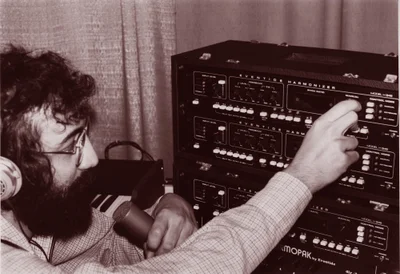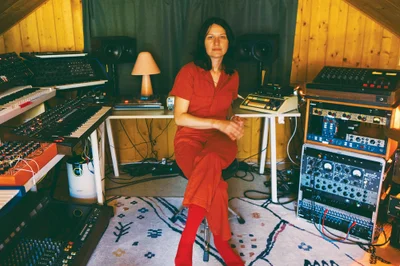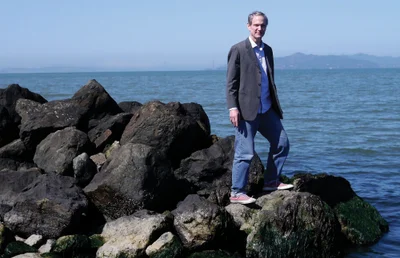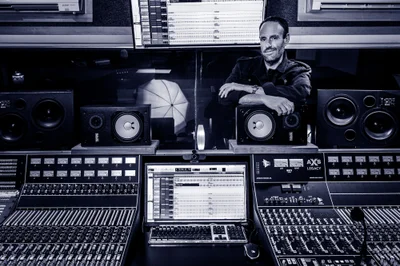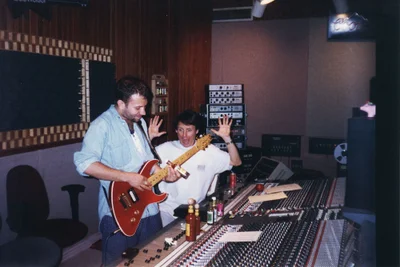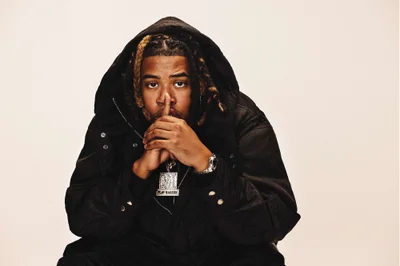Tell me a bit about the room across from what's now the master control room. Was this the beginnings of what ultimately became Eyeland Studio?
Ben Knox Miller: It's currently a "dry" room, as well as a drum school on Saturday mornings, run by Rachel Blumberg. But that was mission control when we first moved in here. It felt a bit like outer space, in the darkness, black curtains, with the gear lights illuminated. You feel like you're mixing in a vacuum. We moved in there for the control, at first, because we wanted to hear exactly what was in the speakers and not be fooling ourselves. We needed to know what the opera house actually sounded like on playback. But soon it got claustrophobic. You could mix a three-piece and be totally cool and comfortable, but any more than that and it was too crowded.
So when you first moved into that small room, you knew you'd be using the rest of the space, eventually?
BKM: We had no plan at all, other than to make our new record. We had 400 feet of snake, a few mics, and a bunch of songs. But the record outgrew that room and we began to see the long-term potential of the space, so we ripped out the kitchen sink, smashed out a window, and built QRD [Quadratic-Residue] diffusors. The kitchen was bigger.
How are you integrating the Columbus Theatre into the studio? It's an incredible space, with so many variations available.
BKM: We built a patchbay that makes it easy to record any sound in any of the acoustical settings in the theatre. The concrete dressing rooms under the mainstage and the large theatre lend themselves as unique natural echo chambers for the studio. Jeffrey Prystowsky: There's a silent movie organ, too. An original Wurlitzer from 1926. The mechanical instruments and pipes are high above the theatre seats, behind the mural.
How did The Low Anthem journey lead you to this place?
BKM: Well, we'd been on tour for about five years, and in the meantime had various warehouse studios where we'd always do our own recording. We'd come home for a few months to work on the record, then move shop again. It seemed that we were moving shop every season, and after five years of not living in one place, or having a permanent setup, we came home and really wanted to decompress for awhile. We had demos for the new album. We packed up our last studio, a decrepit swamp of a mill building where some guy used to breed rare reptiles in North Providence. We were looking for a place where we could keep all of our equipment, because much of it was in my parents' attic. We wanted to find a space that would allow us to become self- sustainable, as well as keep producing work. JP: We were at the end of the Smart Flesh tour, and we were so used to riding into town in the tour bus, looking for the venue, for the pizza place, and whatever forms of alternative media there were available. It was nice to break that routine and decompress back home. I first saw the theatre, and there was an ominous marquee that said "Opening Soon," which hung there for so long that no one really believed it would ever actually open. I suppose it was "soon" in the cosmic sense. [laughs] Anyway, I was having pizza across the street and I thought, "This is a music venue." In Providence, at the time, there was really nothing like it, so I started to research, making some calls. We had no plan, and no real intent to move in. Through a mutual friend, Ben and I got a tour of the theater, which had been closed since 2009. Once we saw it, we knew we had to make our next record here. We'd just come from a pasta sauce factory and the gator pit, so we got the gear out of Ben's parents attic, swept the floors, and started recording!
Was the owner immediately receptive to what you guys wanted to do?
BKM: We knew right away that someone had been using this space in a DIY way. Jon, the theatre's owner, is also a musician, who comes from opera. He has owned the theatre for 50 years, and there are artifacts from all the different eras cluttered in holes, crawl spaces, and crevices throughout the building. It was built in 1926, a year before the first Western Electric theater PA systems were produced, so it's designed to project naturally. He thinks of the room as an instrument for natural singers. For a lot of big hall recordings, the sweet spot has turned out to be the orchestra pit. Go figure. The sound comes up off the hard floor and fills the double proscenium, which then draws the sound out into the room like the bell of a horn. He was excited to be offering the space to amateur acousticians.
When did you open the doors to the public, and how did you go about handling all of the code issues and renovations?
BKM: We opened on November 21st, 2012, and we told him that if he would let us, we'd put our efforts into building something here. It was a gradual process. Once the building was active again, he began showing up more and more. It had been hard for him to see it in the state it was in, but as things improved he found ways to make stuff happen. We fed off each other's energy.
How did you find the time to juggle the band's obligations, and the new record, while handling the Columbus Theatre's reopening?
BKM: What are the responsibilities of a band? We were following our instincts, without knowing where we were heading. The record kept going down every rabbit or wormhole it found. The process started unfolding outwards faster than our band unit could maintain. We came in as a five-piece band, but the other members were restless to get the album out, and to go back on the road. Jeff and I tried to keep the long view. Jocie [Adams] split to start her solo project, Arc Iris. We lost Tyler [Osborne], our guitarist, in the same manner. Two years into our work at the theatre we lost our manager, who took a job at Red Light Management and was given other active artists to work on. Nonesuch, our label, pulled out, and our publisher, Chrysalis, was bought twice. Our professional outfit was going through uncertain change the whole time, but we kept listening for these occasional signs from the universe. We needed to keep on. JP: It's all been about the timing, and not necessarily purpose. What are the odds we'd meet this owner at the perfect time, and he'd be open to us occupying this incredible space? Suddenly we became the people who are running and managing this space, and making all of these changes. While our old structure collapsed, other incredible things seemed to fall into place. Again, we didn't come in thinking about a purpose. This has been, and continues to be, a process.
So now you've got the theatre, the band, and now Eyeland Studio. How are you guys able to manage all of these things? If the new record requires you to hit the road, will you be able to leave the place in capable hands?
JP: Now you're getting inside our minds. [laughs] We've got an incredible team, the most technically talented and soulful engineers around, like Andrew Nault. They can handle things when we hit the road. They know the spirit, though we're sure there will be growing pains. We haven't advertised the studio, and there's no website. It's all been word of mouth, up to this point. We're still putting the pieces together. I mean, there's an element to this story that really is the band behind the theatre. I see Ben down there, building and sanding the stage. We're involved in every gritty aspect.
The studio seems to have evolved in such a short time, with some great buzz. How have you guys evolved as recordists and producers?
BKM: Anything we personally know about recording, we learned by recording. Deconstruction and reconstruction. An approach to sound that is not influenced by gear slut mentality, commercial trends, or anybody's how-to. JP: Our production choices on this record were strongly influenced by a chance trip to Stan Shaff's Audium in San Francisco. It's an immersive sound environment with hundreds of speakers. He shuts the lights off and plays these sound field compositions to a crowd in total darkness. He was combining field recordings, pure sound processes from synthesizers, and various samples in a surround sound sensory deprivation environment that was mesmerizing. After experiencing the Audium, Eyeland, which was nearly done, became totally unchained from its original ideas. We started at the beginning, again. The early recordings that survived became materials that we played with, without any regard or preciousness about their origin. BKM: We treated our work like magazine pages and decided to make some collages.
Brian Webb, your studio partner and systems designer, is a big part of Eyeland.
JP: He's awesome, he's amazing, and he's smart. Brian Webb is an intrepid electrical mechanic, and an empathic, soulful man.
The first few sessions in the new, updated studio was with Brian Blade and the Fellowship Band, as well as Jim White.
JP: August was a bit of a blur, with two of my favorite musicians recording back to back. Working with these world-class artists was amazing. Eyeland is not a clinical environment. I think Brian and Jim felt comfortable and at home recording here.
You recently added a 2-inch Otari MTR-90 24-track analog recorder to the Eyeland setup. How has working with tape changed your approach?
BKM: I like to work for as long as possible, sometimes for 16 hours, 24 hours, or longer. Staring at a screen is exhausting. Hearing the music, rather than looking at a visual representation, is good for me. Also the tape sound doesn't fatigue my ears. Where performance is concerned, each take is do or die. That's nice. Not to mention those little breaks while it rewinds. [laughs]
